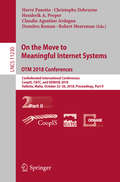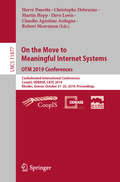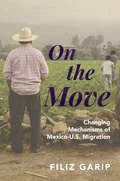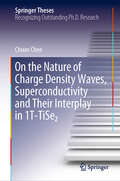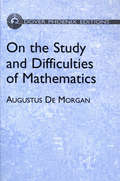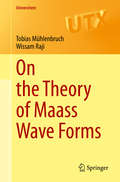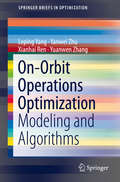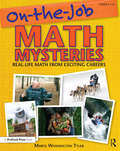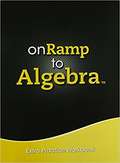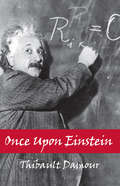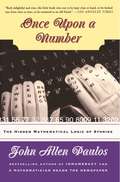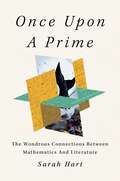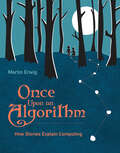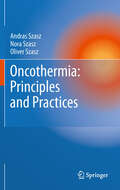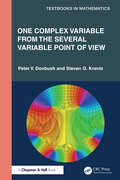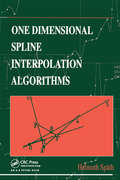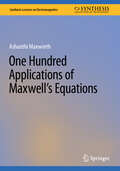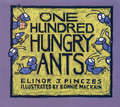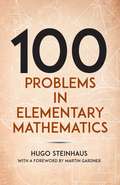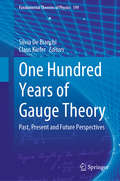- Table View
- List View
On the Move to Meaningful Internet Systems. OTM 2018 Conferences: Confederated International Conferences: CoopIS, C&TC, and ODBASE 2018, Valletta, Malta, October 22-26, 2018, Proceedings, Part II (Lecture Notes in Computer Science #11230)
by Dumitru Roman Christophe Debruyne Hervé Panetto Robert Meersman Claudio Agostino Ardagna Henderik A. ProperThis double volumes LNCS 11229-11230 constitutes the refereed proceedings of the Confederated International Conferences: Cooperative Information Systems, CoopIS 2018, Ontologies, Databases, and Applications of Semantics, ODBASE 2018, and Cloud and Trusted Computing, C&TC, held as part of OTM 2018 in October 2018 in Valletta, Malta. The 64 full papers presented together with 22 short papers were carefully reviewed and selected from 173 submissions. The OTM program every year covers data and Web semantics, distributed objects, Web services, databases, informationsystems, enterprise workflow and collaboration, ubiquity, interoperability, mobility, grid and high-performance computing.
On the Move to Meaningful Internet Systems: Confederated International Conferences: CoopIS, ODBASE, C&TC 2019, Rhodes, Greece, October 21–25, 2019, Proceedings (Lecture Notes in Computer Science #11877)
by Christophe Debruyne Hervé Panetto Robert Meersman Claudio Agostino Ardagna Dave Lewis Martin HeppThis volume LNCS 11877 constitutes the refereed proceedings of the Confederated International Conferences: Cooperative Information Systems, CoopIS 2019, Ontologies, Databases, and Applications of Semantics, ODBASE 2019, and Cloud and Trusted Computing, C&TC, held as part of OTM 2019 in October 2019 in Rhodes, Greece. The 38 full papers presented together with 8 short papers were carefully reviewed and selected from 156 submissions. The OTM program every year covers data and Web semantics, distributed objects, Web services, databases, informationsystems, enterprise workflow and collaboration, ubiquity, interoperability, mobility, grid and high-performance computing.
On the Move: Changing Mechanisms of Mexico-U.S. Migration
by Filiz GaripWhy do Mexicans migrate to the United States? Is there a typical Mexican migrant? Beginning in the 1970s, survey data indicated that the average migrant was a young, unmarried man who was poor, undereducated, and in search of better employment opportunities. This is the general view that most Americans still hold of immigrants from Mexico. On the Move argues that not only does this view of Mexican migrants reinforce the stereotype of their undesirability, but it also fails to capture the true diversity of migrants from Mexico and their evolving migration patterns over time.Using survey data from over 145,000 Mexicans and in-depth interviews with nearly 140 Mexicans, Filiz Garip reveals a more accurate picture of Mexico-U.S migration. In the last fifty years there have been four primary waves: a male-dominated migration from rural areas in the 1960s and '70s, a second migration of young men from socioeconomically more well-off families during the 1980s, a migration of women joining spouses already in the United States in the late 1980s and '90s, and a generation of more educated, urban migrants in the late 1990s and early 2000s. For each of these four stages, Garip examines the changing variety of reasons for why people migrate and migrants' perceptions of their opportunities in Mexico and the United States. Looking at Mexico-U.S. migration during the last half century, On the Move uncovers the vast mechanisms underlying the flow of people moving between nations.
On the Nature of Charge Density Waves, Superconductivity and Their Interplay in 1T-TiSe₂ (Springer Theses)
by Chuan ChenThis thesis presents analytical theoretical studies on the interplay between charge density waves (CDW) and superconductivity (SC) in the actively studied transition-metal dichalcogenide 1T-TiSe2. It begins by reapproaching a years-long debate over the nature of the phase transition to the commensurate CDW (CCDW) state and the role played by the intrinsic tendency towards excitonic condensation in this system. A Ginzburg-Landau phenomenological theory was subsequently developed to understand the experimentally observed transition from commensurate to incommensurate CDW (ICDW) order with doping or pressure, and the emergence of a superconducting dome that coexists with ICDW. Finally, to characterize microscopically the effects of the interplay between CDW and SC, the spectrum of CDW fluctuations beyond mean-field was studied in detail. In the aggregate, the work reported here provides an encompassing understanding of what are possibly key microscopic underpinnings of the CDW and SC physics in TiSe2.
On the Study and Difficulties of Mathematics
by Augustus De MorganOne of the twentieth century's most eminent mathematical writers, Augustus De Morgan enriched his expositions with insights from history and psychology. On the Study and Difficulties of Mathematics represents some of his best work, containing points usually overlooked by elementary treatises, and written in a fresh and natural tone that provides a refreshing contrast to the mechanical character of common textbooks.Presuming only a knowledge of the rules of algebra and Euclidean theorems, De Morgan begins with some introductory remarks on the nature and objects of mathematics. He discusses the concept of arithmetical notion and its elementary rules, including arithmetical reactions and decimal fractions. Moving on to algebra, he reviews the elementary principles, examines equations of the first and second degree, and surveys roots and logarithms. De Morgan's book concludes with an exploration of geometrical reasoning that encompasses the formulation and use of axioms, the role of proportion, and the application of algebra to the measurement of lines, angles, the proportion of figures, and surfaces.
On the Theory of Maass Wave Forms (Universitext)
by Tobias Mühlenbruch Wissam RajiThis textbook provides a rigorous analytical treatment of the theory of Maass wave forms. Readers will find this unified presentation invaluable, as it treats Maass wave forms as the central area of interest. Subjects at the cutting edge of research are explored in depth, such as Maass wave forms of real weight and the cohomology attached to Maass wave forms and transfer operators. Because Maass wave forms are given a deep exploration, this book offers an indispensable resource for those entering the field.Early chapters present a brief introduction to the theory of classical modular forms, with an emphasis on objects and results necessary to fully understand later material. Chapters 4 and 5 contain the book’s main focus: L-functions and period functions associated with families of Maass wave forms. Other topics include Maass wave forms of real weight, Maass cusp forms, and weak harmonic Maass wave forms. Engaging exercises appear throughout the book, with solutions available online.On the Theory of Maass Wave Forms is ideal for graduate students and researchers entering the area. Readers in mathematical physics and other related disciplines will find this a useful reference as well. Knowledge of complex analysis, real analysis, and abstract algebra is required.
On-Orbit Operations Optimization
by Leping Yang Yanwei Zhu Xianhai Ren Yuanwen ZhangOn-orbit operations optimization among multiple cooperative or noncooperative spacecraft, which is often challenged by tight constraints and shifting parameters, has grown to be a hot issue in recent years. The authors of this book summarize related optimization problems into four planning categories: spacecraft multi-mission planning, far-range orbital maneuver planning, proximity relative motion planning and multi-spacecraft coordinated planning. The authors then formulate models, introduce optimization methods, and investigate simulation cases that address problems in these four categories. This text will serve as a quick reference for engineers, graduate students, postgraduates in the fields of optimization research and on-orbit operation mission planning.
On-the-Job Math Mysteries: Real-Life Math From Exciting Careers (Grades 4-8)
by Marya Washington TylerThe author of the best-selling Real Life Math Mysteries offers students more close encounters with engaging professionals! After working through the math problems encountered on the job, your students will have no doubt about the absolute importance of math in the real world. Just like a field trip, but a lot more practical, this book takes students out into the field where they count fish, direct air traffic, carve a totem pole, write software code, care for orphaned sea creatures, recover sunken valuables, mush dogs, salvage timber, feed the homeless, film wildlife, and a lot more.The math problems are tied to NCTM standards, and students will use skills such as selecting an operation, determining place value, using fractions and decimals, working with geometry, applying measurement skills, estimating, and recording and analyzing data to solve them. Each set of problems is presented on separate reproducible worksheets, and the book includes a list of skills and comprehensive answer key.Working with the engaging and diverse mathematics presented here, students will see exactly what is at stake in problem solving, why mathematics is essential, and why accuracy matters. The light will go on for your students as they see that mathematical skills are essential to following their dreams.Grades 4-8
OnRamp to Algebra: Extra Practice Workbook (Grade 7-9)
by Prentice HallOnramp To Algebra 2013 Extra Practice Workbook Grade 7/9
Once Upon Einstein
by Thibault DamourIt is well known that Einstein founded twentieth-century physics with his work on relativity and quanta, but what do we really know about these ground breaking ideas? How were they discovered? What should we retain today from the conceptual upheavals he initiated? Through a selection of concrete scenes taken from Einstein's life, the author offers
Once Upon a Number: The Hidden Mathematical Logic of Stories
by John Allen PaulosWhat two things could be more different than numbers and stories? Numbers are abstract, certain, and eternal, but to most of us somewhat dry and bloodless. Good stories are full of life: they engage our emotions and have subtlety and nuance, but they lack rigor and the truths they tell are elusive and subject to debate. As ways of understanding the world around us, numbers and stories seem almost completely incompatible. Once Upon a Number shows that stories and numbers aren’t as different as you might imagine, and in fact they have surprising and fascinating connections. The concepts of logic and probability both grew out of intuitive ideas about how certain situations would play out. Now, logicians are inventing ways to deal with real world situations by mathematical means--by acknowledging, for instance, that items that are mathematically interchangeable may not be interchangeable in a story. And complexity theory looks at both number strings and narrative strings in remarkably similar terms. Throughout, renowned author John Paulos mixes numbers and narratives in his own delightful style. Along with lucid accounts of cutting-edge information theory we get hilarious anecdotes and jokes; instructions for running a truly impressive pyramid scam; a freewheeling conversation between Groucho Marx and Bertrand Russell (while they’re stuck in an elevator together); explanations of why the statistical evidence against OJ Simpson was overwhelming beyond doubt and how the Unabomber’s thinking shows signs of mathematical training; and dozens of other treats. This is another winner from America’s favorite mathematician.
Once Upon a Prime: The Wondrous Connections Between Mathematics and Literature
by Sarah HartA New York Times Book Review Editors’ Choice “Wide-ranging and thoroughly winning.” —Jordan Ellenberg, The New York Times Book Review“An absolute joy to read!" —Steven Levitt, New York Times bestselling author of Freakonomics For fans of Seven Brief Lessons in Physics, an exploration of the many ways mathematics can transform our understanding of literature and vice versa, by the first woman to hold England's oldest mathematical chair.We often think of mathematics and literature as polar opposites. But what if, instead, they were fundamentally linked? In her clear, insightful, laugh-out-loud funny debut, Once Upon a Prime, Professor Sarah Hart shows us the myriad connections between math and literature, and how understanding those connections can enhance our enjoyment of both. Did you know, for instance, that Moby-Dick is full of sophisticated geometry? That James Joyce’s stream-of-consciousness novels are deliberately checkered with mathematical references? That George Eliot was obsessed with statistics? That Jurassic Park is undergirded by fractal patterns? That Sir Arthur Conan Doyle and Chimamanda Ngozi Adichie wrote mathematician characters? From sonnets to fairytales to experimental French literature, Professor Hart shows how math and literature are complementary parts of the same quest, to understand human life and our place in the universe. As the first woman to hold England’s oldest mathematical chair, Professor Hart is the ideal tour guide, taking us on an unforgettable journey through the books we thought we knew, revealing new layers of beauty and wonder. As she promises, you’re going to need a bigger bookcase.
Once Upon an Algorithm: How Stories Explain Computing (The\mit Press Ser.)
by Martin ErwigHow Hansel and Gretel, Sherlock Holmes, the movie Groundhog Day, Harry Potter, and other familiar stories illustrate the concepts of computing.Picture a computer scientist, staring at a screen and clicking away frantically on a keyboard, hacking into a system, or perhaps developing an app. Now delete that picture. In Once Upon an Algorithm, Martin Erwig explains computation as something that takes place beyond electronic computers, and computer science as the study of systematic problem solving. Erwig points out that many daily activities involve problem solving. Getting up in the morning, for example: You get up, take a shower, get dressed, eat breakfast. This simple daily routine solves a recurring problem through a series of well-defined steps. In computer science, such a routine is called an algorithm.Erwig illustrates a series of concepts in computing with examples from daily life and familiar stories. Hansel and Gretel, for example, execute an algorithm to get home from the forest. The movie Groundhog Day illustrates the problem of unsolvability; Sherlock Holmes manipulates data structures when solving a crime; the magic in Harry Potter's world is understood through types and abstraction; and Indiana Jones demonstrates the complexity of searching. Along the way, Erwig also discusses representations and different ways to organize data; “intractable” problems; language, syntax, and ambiguity; control structures, loops, and the halting problem; different forms of recursion; and rules for finding errors in algorithms.This engaging book explains computation accessibly and shows its relevance to daily life. Something to think about next time we execute the algorithm of getting up in the morning.
Once, Only Once, and in the Right Place: Residence Rules in the Decennial Census
by Panel on Residence Rules in the Decennial CensusThe usefulness of the U.S. decennial census depends critically on the accuracy with which individual people are counted in specific housing units, at precise geographic locations. The 2000 and other recent censuses have relied on a set of residence rules to craft instructions on the census questionnaire in order to guide respondents to identify their correct &#34usual residence.&#34 Determining the proper place to count such groups as college students, prisoners, and military personnel has always been complicated and controversial; major societal trends such as placement of children in shared custody arrangements and the prevalence of &#34snowbird&#34 and &#34sunbird&#34 populations who regularly move to favorable climates further make it difficult to specify ties to one household and one place. Once, Only Once, and in the Right Place reviews the evolution of current residence rules and the way residence concepts are presented to respondents. It proposes major changes to the basic approach of collecting residence information and suggests a program of research to improve the 2010 and future censuses.
Oncothermia: Principles and Practices
by Andras Szasz Nora Szasz Oliver SzaszOncothermia is the next generation medical innovation that delivers selective, controlled and deep energy for cancer treatment. The basic principles for oncothermia stem from oncological hyperthermia, the oldest approach to treating cancer. Nevertheless, hyperthermia has been wrought with significant controversy, mostly stemming from shortcomings of controlled energy delivery. Oncothermia has been able to overcome these insufficiencies and prove to be a controlled, safe and efficacious treatment option. This book is the first attempt to elucidate the theory and practice of oncothermia, based on rigorous mathematical and biophysical analysis, not centered on the temperature increase. It is supported by numerous in-vitro and in-vivo findings and twenty years of clinical experience. This book will help scientists, researchers and medical practitioners in understanding the scientific and conceptual underpinnings of oncothermia and will add another valuable tool in the fight against cancer. Professor Andras Szasz is the inventor of oncothermia and the Head of St Istvan University's Biotechnics Department in Hungary. He has published over 300 papers and lectured at various universities around the world. Dr. Oliver Szasz is the managing director of Oncotherm, the global manufacturer and distributor of medical devices for cancer treatment used in Europe & Asia since the late 1980s. Dr. Nora Szasz is currently a management consultant in healthcare for McKinsey & Co.
One (Bookworms Count on It!)
by Dana Meachen RauPublisher's summary: Identifies things that inherently come in ones and lists other examples. The simple and engaging text and photos of Count On It! accomplish two things at once: They teach children how to count as well as to read. The direct correspondence between image and text and consistent format make these books ideal for the beginning reader and mathematician.
One Cent, Two Cents, Old Cent, New Cent: All About Money
by Bonnie WorthTHE CAT IN the Hat puts to rest any notion that money grows on trees in this super simple look at numismatics, the study of money and its history. Beginning with the ancient practice of bartering, the Cat explains various forms of money used in different cultures, from shells, feathers, leather, and jade to metal ingots to coins (including the smallest—the BB-like Indian fanam—and the largest—the 8-foot-wide, ship-sinking limestone ones from the Islands of Yap!), to the current king of currency, paper. Also included is a look at banking, from the use of temples as the first banks to the concept of gaining or paying interest, and a step-by-step guide to minting coins. A fascinating introduction is bound to change young reader’s appreciation for change!
One Complex Variable from the Several Variable Point of View (Textbooks in Mathematics)
by Steven G. Krantz Peter V. DovbushTraditionally speaking, those who study the function theory of one complex variable spend little or no time thinking about several complex variables. Conversely, experts in the function theory of several complex variables do not consider one complex variable. One complex variable is the inspiration and testing ground for several complex variables, and several complex variables are the natural generalization of one complex variable.The authors’ thesis here is that these two subject areas have much in common. These subject areas can gain a lot by learning to communicate with each other. These two fields are logically connected, and each can be used to explain and put the other into context. This is the purpose of this book.The point of view and the methodology of the two subject areas are quite different. One complex variable is an aspect of traditional hard analysis. Several complex variables are more like algebraic geometry and differential equations, with some differential geometry thrown in. The authors intend to create a marriage of the function theory of one complex variable and the function theory of several complex variables, leading to a new and productive dialogue between the two disciplines.The hope is for this book to foster and develop this miscegenation in a manner that leads to new collaborations and developments. There is much fertile ground here, and this book aims to breathe new life into it.
One Dimensional Spline Interpolation Algorithms
by Helmuth SpäthTogether with its compagnion volume this book presents a practical introduction to computing spline functions, the fundamental tools for fitting curves and surfaces in computer-aided design (CAD) and computer graphics.
One Hundred Applications of Maxwell’s Equations (Synthesis Lectures on Electromagnetics)
by Ashanthi MaxworthMaxwell's equations explain the basics of electricity and magnetism. The four equations provide a mathematical model for electric, optical, and radio technologies. And yet, when learning electromagnetic field theory, it is easy to get lost in the complicated mathematics and ignore the applied aspects of it. The purpose of this book is to bridge the gap between theory and applications of Maxwell’s equations. This book introduces readers to the mathematics of Maxwell’s equations and their uses in both everyday applications such as power generation, electric motors, wireless communication, as well as in scientific research. Each chapter in the book starts with an introduction to a specific Maxwell’s equation followed by examples of ways in which the equation is used.
One Hundred Hungry Ants
by Elinor J. PinczesThis tale of ants parading toward a picnic is &“one of those rare gems capable of entertaining while it instructs&” (Middlesex News). One hundred hungry ants march off single file to sample a picnic, but when the going gets too slow, they divide into two rows of fifty, then four rows of twenty-five . . . until they take so long that the picnic is gone! &“The unexpected pairing of sophisticated art and light-hearted text lends this book particular distinction.&” —Publishers Weekly &“The illustrations . . . use a pleasing palette and energetic lines to depict ants with highly individual characters.&” —Horn Book
One Hundred Prisoners and a Light Bulb
by Hans Van Ditmarsch Barteld KooiA group of 100 prisoners, all together in the prison dining area, are told that they will be all put in isolation cells and then will be interrogated one by one in a room containing a light with an on/off switch. The prisoners may communicate with one another by toggling the light switch (and that is the only way in which they can communicate). The light is initially switched off. There is no fixed order of interrogation, or interval between interrogations, and the same prisoner may be interrogated again at any stage. When interrogated, a prisoner can either do nothing, or toggle the light switch, or announce that all prisoners have been interrogated. If that announcement is true, the prisoners will (all) be set free, but if it is false, they will all be executed. While still in the dining room, and before the prisoners go to their isolation cells (forever), can the prisoners agree on a protocol that will set them free? At first glance, this riddle may seem impossible to solve: how can all of the necessary information be transmitted by the prisoners using only a single light bulb? There is indeed a solution, however, and it can be found by reasoning about knowledge. This book provides a guided tour through eleven classic logic puzzles that are engaging and challenging and often surprising in their solutions. These riddles revolve around the characters' declarations of knowledge, ignorance, and the appearance that they are contradicting themselves in some way. Each chapter focuses on one puzzle, which the authors break down in order to guide the reader toward the solution. For general readers and students with little technical knowledge of mathematics, One Hundred Prisoners and a Light Bulb will be an accessible and fun introduction to epistemic logic. Additionally, more advanced students and their teachers will find it to be a valuable reference text for introductory course work and further study.
One Hundred Problems in Elementary Mathematics (Dover Books on Mathematics)
by Martin Gardner Hugo SteinhausBoth a challenge to mathematically inclined readers and a useful supplementary text for high school and college courses, One Hundred Problems in Elementary Mathematics presents an instructive, stimulating collection of problems. Many problems address such matters as numbers, equations, inequalities, points, polygons, circles, ellipses, space, polyhedra, and spheres. An equal number deal with more amusing or more practical subjects, such as a picnic ham, blood groups, rooks on a chessboard, and the doings of the ingenious Dr. Abracadabrus.Are the problems in this book really elementary? Perhaps not in the lay reader’s sense, for anyone who desires to solve these problems must know a fair amount of mathematics, up to calculus. Nevertheless, Professor Steinhaus has given complete, detailed solutions to every one of his 100 problems, and anyone who works through the solutions will painlessly learn an astonishing amount of mathematics. A final chapter provides a true test for the most proficient readers: 13 additional unsolved problems, including some for which the author himself does not know the solutions.
One Hundred Years of Gauge Theory: Past, Present and Future Perspectives (Fundamental Theories of Physics #199)
by Claus Kiefer Silvia De BianchiThis book presents a multidisciplinary guide to gauge theory and gravity, with chapters by the world’s leading theoretical physicists, mathematicians, historians and philosophers of science. The contributions from theoretical physics explore e.g. the consistency of the unification of gravitation and quantum theory, the underpinnings of experimental tests of gauge theory and its role in shedding light on the relationship between mathematics and physics. In turn, historians and philosophers of science assess the impact of Weyl’s view on the philosophy of science. Graduate students, lecturers and researchers in the fields of history of science, theoretical physics and philosophy of science will benefit from this book by learning about the role played by Weyl’s Raum-Zeit-Materie in shaping several modern research fields, and by gaining insights into the future prospects of gauge theory in both theoretical and experimental physics. Furthermore, the book facilitates interdisciplinary exchange and conceptual innovation in tackling fundamental questions about our deepest theories of physics. Chapter “Weyl’s Raum-Zeit-Materie and the Philosophy of Science” is available open access under a Creative Commons Attribution 4.0 International License via link.springer.com
